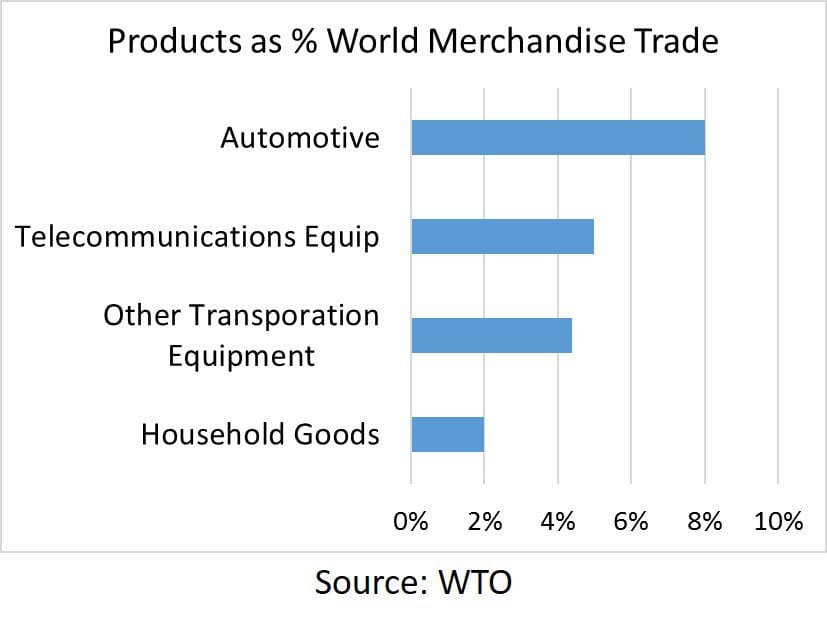Congratulations to me! I have (finally) completed ARC’s Global Trade Management Systems Market Research Study. I will take this opportunity to communicate and consolidate the  research findings from the study and the accompanying writing I published over the last few months in Logistics Viewpoints.
research findings from the study and the accompanying writing I published over the last few months in Logistics Viewpoints.
The GTM Solutions Market
ARC focuses its GTM research on two high-level functionality sets: Trade Compliance – functionality for managing trade compliance costs and processes like duties, tariffs, restricted party screening, etc., and International Trade Visibility & Execution – functionality that enables companies with geographically dispersed trading partners to collaborate, monitor, and manage the steps within the procurement, production, and delivery processes. In my opinion, trade tariffs often act as a form of tax that disturbs the supply and demand equilibrium, and ends up creating an economic inefficiency known as a tax wedge (see Global Trade Management Software –Execution, Visibility, Compliance …and that Darn Tax Wedge). One part of that wedge is an increased cost of an item that could otherwise be procured more efficiently. The increased cost decreased demand (or shifts it to the next best provider) and increases product costs. In fact, the costs can be so substantial that they can influence entire supply chains. So it’s no wonder that free trade agreements are such hotly debated topics.
Most GTM software vendors currently sell their solutions through the SaaS model. In fact, roughly half of the GTM market’s revenues come in the form of SaaS. This allows for easier adoption of GTM solutions and many vendors are allowing the purchase of subsets of functionality to lower barriers to adoption even further. However, the overarching adoption trend is that of GTM suppliers expanding their solution footprints, allowing them to sell their solutions as a GTM platform. This allows users to purchase a system that is more standardized, offers greater continuity across the enterprise (i.e. compliance for multiple business units across countries on one platform), and provides customers with integration benefits.
GTM Solutions in Use
Growth in trade and the value and complexity of goods are drivers of GTM solution usage. The WTO shows that 2016 merchandise trade did grow, but at a slow rate of 1.3 percent.  Fortunately, the WTO is projecting more robust trade volume growth in 2017 and 2018. ARC’s research shows Industrial Machinery, Automotive, Food & Beverage, Electronics, and Household items as leading end-user industries for use of GTM solutions. These industries are well aligned with global merchandise category trade volumes and recent trends in the trade of these items. Worldwide export (value in dollars) of household goods grew by 6% a year between 2010 and 2015. Over the same period, Automotive averaged 4% a year. Telecommunications equipment was the category that experienced the fastest growth in 2015 (for more detailed information, see GTM Research Update: Merchandise Trade Analysis).
Fortunately, the WTO is projecting more robust trade volume growth in 2017 and 2018. ARC’s research shows Industrial Machinery, Automotive, Food & Beverage, Electronics, and Household items as leading end-user industries for use of GTM solutions. These industries are well aligned with global merchandise category trade volumes and recent trends in the trade of these items. Worldwide export (value in dollars) of household goods grew by 6% a year between 2010 and 2015. Over the same period, Automotive averaged 4% a year. Telecommunications equipment was the category that experienced the fastest growth in 2015 (for more detailed information, see GTM Research Update: Merchandise Trade Analysis).
The primary incentive for adopting GTM for trade compliance purposes is transitioning from general regulatory compliance, toward the management of regulatory programs to the benefit of the organization. In particular, companies are using GTM solutions to take full advantage of preferential treatment programs. Most notably, they’re using GTM solutions for item classification and other process steps to harness the benefits of FTAs (avoiding the costly tariffs referenced above).
Using GTM to Harness Benefits from Free Trade Agreements
Companies in the automotive industry frequently use GTM solutions to harness the preferential treatment benefits made available through free trade agreements. I had the opportunity to speak with an executive from a large automotive manufacturer that uses MIC’s origin calculation system when analyzing sourcing and production scenarios for new vehicle launches and ongoing production thereafter (for more detailed information, see How Free Trade Influences an Automotive Supply Chain). Local content feasibility and assembly layout are evaluated during the concept phase. But what I found most impressive about this process is that the local content is not only projected for a given make and model, but also subsequently calculated for each vehicle around the time of production. For example, if a plant produces 200 vehicles in a day, the local content calculation is performed 200 times that day.
Corporate Actions in GTM Market (that’s mostly M&A to you and me)
The GTM market is still mostly made up of best-of-breed suppliers. Only a few ERP suppliers offer GTM solutions, but I expect more to acquire providers or build their own solutions in the future. The ERP suppliers that currently offer GTM solutions include SAP, Oracle, Infor (GT Nexus), and QAD. Some of the more prominent best-of-breed GTM suppliers include (in alphabetical order) AEB, Amber Road, BluJay, Descartes, Integration Point, MIC Customs, and WiseTech Global. Amber Road, Descartes, and WiseTech Global are the only best-of-breed GTM suppliers that are currently publicly traded companies. Descartes and WiseTech Global have been periodically acquiring smaller GTM suppliers to expand upon their existing GTM portfolio. The largest acquisition in the market is Infor’s 2015 acquisition of GT Nexus (and GT Nexus merged with TradeCard in 2013). Finally, Thomson Reuters and Livingston both acquired GTM providers in the recent past to expand upon their respective offerings, as well. I expect a number of additional mergers and acquisitions to occur in the near future, driven by the attractive growth rate of GTM solution sales and the broader supply chain technology convergence trend.
For further information on ARC’s Global Trade Management Research, go to https://www.arcweb.com/market-studies/global-trade-management.

















Leave a Reply